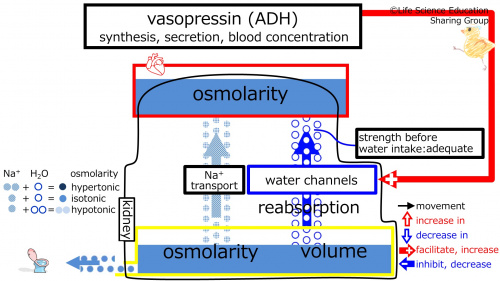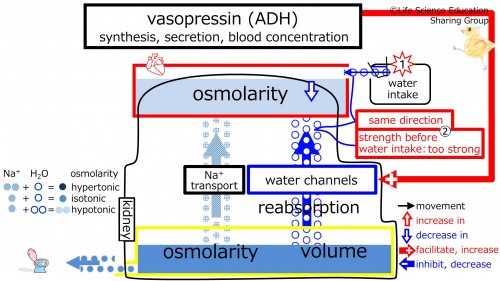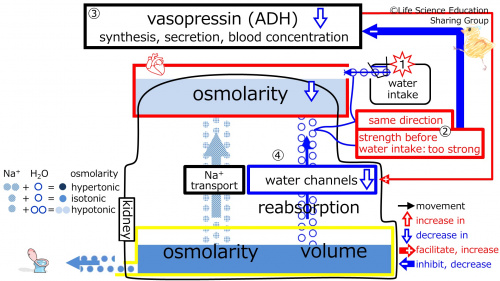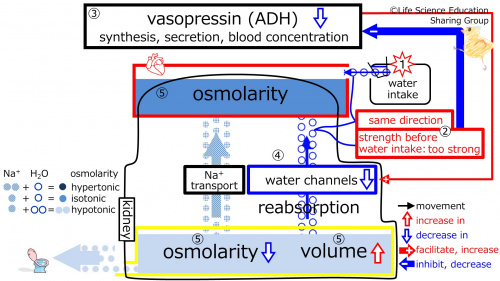「SHolroydAtWeilCornellMedQatar/Endocrinology/VasopressinADH/ControlToWaterIntake」の版間の差分
編集の要約なし |
編集の要約なし |
||
| 56行目: | 56行目: | ||
//LEVEL:3 | //LEVEL:3 | ||
//RAND | //RAND | ||
With water intake, the plasma osmolarity {~increases~=decreases}. This is in the {~=same direction as~opposite direction to} the plasma {~osmolarity-increasing~=osmolarity-decreasing} effect of the water reabsorption from the tubule (through the water channels). The negative feedback {~increases~=decreases} (the synthesis, secretion, and blood concentration of) vasopressin (ADH). This will {~=increase~decrease} plasma osmolarity (towards isotonic).飲水により血漿浸透圧は {~上昇~=低下}する。これは、腎臓/尿細管からの(水チャンネルを通じての)水分再吸収の血漿浸透圧 {~上昇~=低下}作用と{=同じ~逆の}方向であり、負のフィードバックは、尿細管の水チャンネルを{~増加~=減少}させ、水分再吸収を{~増加~=減少}させる。これは血漿浸透圧を(等張へ向けて){=上昇~低下}させる。 | With water intake, the plasma osmolarity {~increases~=decreases}. This is in the {~=same direction as~opposite direction to} the plasma {~osmolarity-increasing~=osmolarity-decreasing} effect of the water reabsorption from the tubule (through the water channels, which are increased by vasopressin, ADH). The negative feedback {~increases~=decreases} (the synthesis, secretion, and blood concentration of) vasopressin (ADH). This will {~=increase~decrease} plasma osmolarity (towards isotonic).飲水により血漿浸透圧は {~上昇~=低下}する。これは、腎臓/尿細管からの(水チャンネルを通じての)水分再吸収の血漿浸透圧 {~上昇~=低下}作用と{=同じ~逆の}方向であり、負のフィードバックは、尿細管の水チャンネルを{~増加~=減少}させ、水分再吸収を{~増加~=減少}させる。これは血漿浸透圧を(等張へ向けて){=上昇~低下}させる。 | ||
//LEVEL:4 | //LEVEL:4 | ||
2020年3月30日 (月) 17:01時点における版
| With water intake, the plasma osmolarity decreases, and negative feedback decreases the synthesis, secretion, and blood concentration of vasopressin (anti-diuretic hormone, ADH). |
Before water intake (at baseline), we will make the assumption that the subject is in homeostasis with adequate strength of the plasma osmolarity-decreasing effect of water reabsorption (through the water channels, which are increased by vasopressin, ADH) as well as normal plasma and urine osmolarities (isotonic) and urine volume.
Step 1: With water intake, water enters the plasma and osmolarity decreases (diluted, hypotonic).
Step 2: This is in the same direction as the plasma osmolarity-decreasing effect of the water reabsorption (through the water channels, which are increased by vasopressin, ADH). Thus, although the strength of the plasma osmolarity-decreasing effect of water reabsorption (through the water channels, which are increased by vasopressin, ADH) was adequate before water intake (at baseline), this strength is now too strong (red) to reverse the decreased plasma osmolarity (diluted, hypotonic) produced by water intake. Control by negative feedback is needed.
Step 3: With the strength of the plasma osmolarity-decreasing effect of the water reabsorption (through the water channels, which are increased by vasopressin, ADH) before water intake (at baseline) being too strong (red), the negative feedback decreases (blue) (the synthesis, secretion, and blood concentration of) vasopressin (ADH).
Step 4: The water channel-increasing effect of vasopressin (ADH) becomes weaker, which decreases the number of water channels. This decreases the water reabsorption from the tubule.
Step 5: With the decrease in water reabsorption, concentrated (hypertonic) solution enters the plasma. This will lead to a reverse in the decreased plasma osmolarity (diluted, hypotonic) produced by water intake, increasing it towards normal (baseline, isotonic) osmolarity. Because concentrated (hypertonic) solution leaves the tubule due to reabsorption, the fluid remaining in the tubule has a decreased osmolarity (diluted, hypotonic). Also, with the decrease in water reabsorption, there is more water remaining in the tubule. Overall, the urine becomes diluted and increases in volume.
Challenge Quiz
With water intake, the plasma osmolarity decreases, and negative feedback increases decreases the synthesis, secretion, and blood concentration of vasopressin (anti-diuretic hormone, ADH).
With water intake, the plasma osmolarity increases decreases . This is in the same direction as opposite direction to the plasma osmolarity-increasing osmolarity-decreasing effect of the water reabsorption from the tubule (through the water channels, which are increased by vasopressin, ADH). The negative feedback increases decreases (the synthesis, secretion, and blood concentration of) vasopressin (ADH). This will increase decrease plasma osmolarity (towards isotonic).飲水により血漿浸透圧は 上昇 低下 する。これは、腎臓/尿細管からの(水チャンネルを通じての)水分再吸収の血漿浸透圧 上昇 低下 作用と 同じ 逆の 方向であり、負のフィードバックは、尿細管の水チャンネルを 増加 減少 させ、水分再吸収を 増加 減少 させる。これは血漿浸透圧を(等張へ向けて) 上昇 低下 させる。
With water intake, water enters leaves the plasma and osmolarity increases decreases . This is in the same direction as opposite direction to the plasma osmolarity-decreasing effect of the water reabsorption (through the water channels, which are increased by vasopressin, ADH). Thus, although the strength of the plasma osmolarity-decreasing effect of water reabsorption (through the water channels, which are increased by vasopressin, ADH) was too strong adequate too weak before water intake (at baseline), this strength is now too strong adequate too weak to reverse the increased decreased plasma osmolarity produced by water intake. The negative feedback increases decreases (the synthesis, secretion, and blood concentration of) vasopressin (ADH). The water channel-increasing effect of vasopressin (ADH) becomes stronger weaker , which increases decreases the number of water channels. With the increases decrease in water reabsorption from the tubule, concentrated diluted solution enters the plasma. This will lead to a reverse in the increased decreased plasma osmolarity from water intake, increasing decreasing it towards separate from normal osmolarity. Because concentrated diluted solution leaves the tubule due to reabsorption, the fluid remaining in the tubule has an increased a decreased osmolarity. Also, with the increase decrease in water reabsorption, there is more less water remaining in the tubule. Overall, the urine becomes concentrated diluted and increases decreases in volume.




